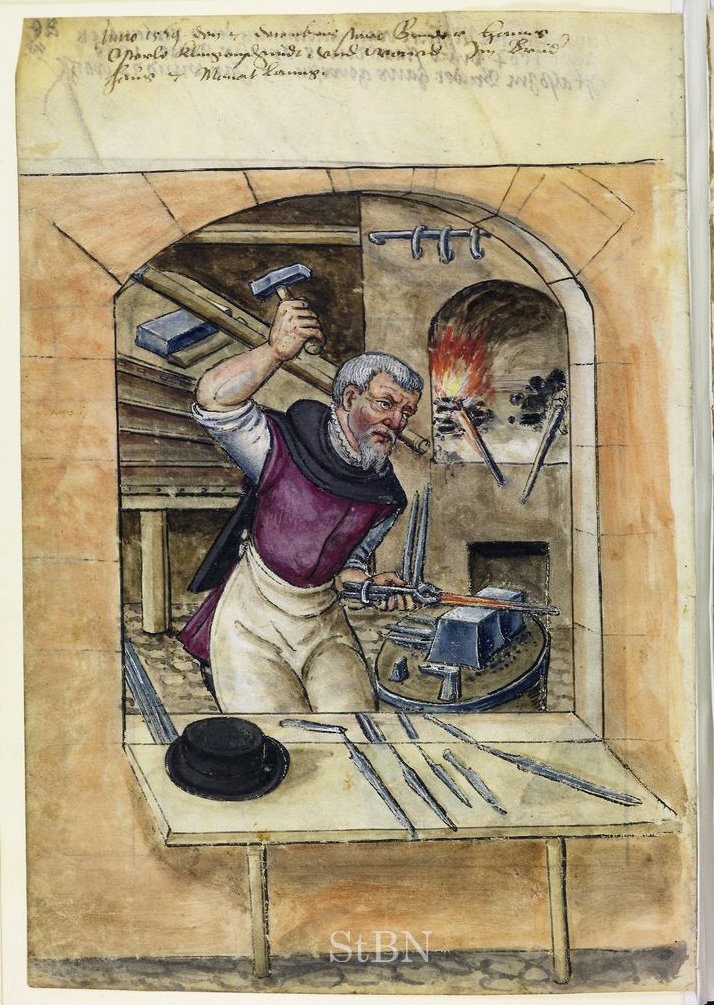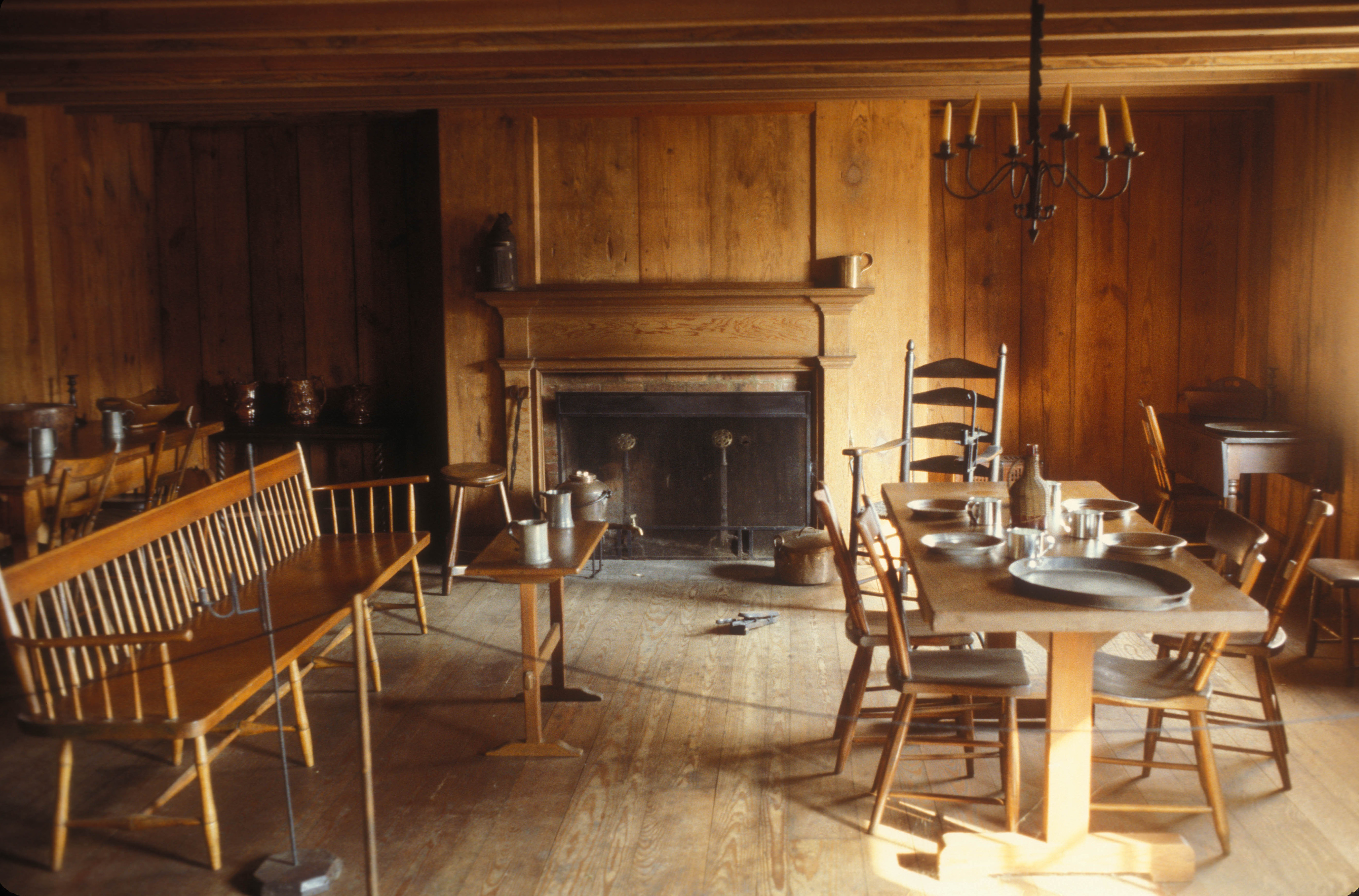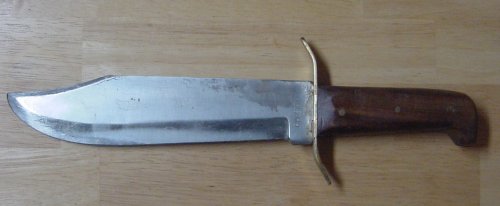|
American Bladesmith Society
The American Bladesmith Society, or ABS, is a non-profit organization composed of knifemakers whose primary function is to promote the techniques of forging steel blades. The ABS was founded by knifemaker William F. Moran, who came up with the concept in 1972 when he was Chairman of the Knifemakers' Guild; the following year, he introduced Damascus steel blades at an annual show. In 1976, he incorporated the organization, and it received non-profit status in 1985. ABS knifemakers forge their blades, as opposed to making them via the stock-removal method. The ABS has developed a system of ratings designating whether a member is an Apprentice, a Journeyman, or a Master smith. The ABS has partnered with several colleges to offer courses in bladesmithing and has launched its own museum. As of 2022, the chairman of the board of directors of ABS is Steve Dunn. History Bill Moran had been elected chairman of the Knifemakers' Guild in 1972. At that time, there were fewer than a dozen pr ... [...More Info...] [...Related Items...] OR: [Wikipedia] [Google] [Baidu] |
Knifemaker
Knife making is the process of manufacturing a knife by any one or a combination of processes: stock removal, forging to shape, welded lamination or investment cast. Typical metals used come from the carbon steel, tool, or stainless steel families. Primitive knives have been made from bronze, copper, brass, iron, obsidian, and flint. Materials for blades Different steels are suited to different applications. There is a trade off between hardness, toughness, edge retention, corrosion resistance, and achievable sharpness. Some examples of blade material and their relative trade offs: *The newest powder metallurgy steels can be made very hard, but can quickly wear out abrasives and tooling. *A blade made from low carbon or mild steel would be inexpensive to produce and of poor quality. A low carbon blade would be very hard to break, but would bend easily and be too soft to hold an edge. High carbon (or high alloy, in some listings) can take a much higher hardness but must be te ... [...More Info...] [...Related Items...] OR: [Wikipedia] [Google] [Baidu] |
James Black (blacksmith)
James Black (May 1, 1800 - June 22, 1872) was an American knifemaker best known for his improvements to the Bowie knife designed by Jim Bowie. Early life James Black was born in Hackensack, New Jersey on 1 May 1800. James' mother died when he was very young and he had difficulty getting along with his stepmother. Black ran away from home to Philadelphia, Pennsylvania at age 8 and was apprenticed to a silversmith. At age 18 he migrated westward and took jobs on the Ohio and Mississippi rivers. About 1820 Black spent some time at Bayou Sara in Louisiana working as a ferryman and as a steamboat deckhand on the Red River which took him upstream to Fulton, Arkansas. Black left the boat and settled at a crossroads 14 miles northeast of Fulton that would later become Washington, Arkansas and Black's permanent home. Partnership with William Shaw During his travels, Black had befriended Elijah Stuart. Stuart opened a tavern at Washington and Black was hired by a local blacksmith named ... [...More Info...] [...Related Items...] OR: [Wikipedia] [Google] [Baidu] |
American Bladesmith Society
The American Bladesmith Society, or ABS, is a non-profit organization composed of knifemakers whose primary function is to promote the techniques of forging steel blades. The ABS was founded by knifemaker William F. Moran, who came up with the concept in 1972 when he was Chairman of the Knifemakers' Guild; the following year, he introduced Damascus steel blades at an annual show. In 1976, he incorporated the organization, and it received non-profit status in 1985. ABS knifemakers forge their blades, as opposed to making them via the stock-removal method. The ABS has developed a system of ratings designating whether a member is an Apprentice, a Journeyman, or a Master smith. The ABS has partnered with several colleges to offer courses in bladesmithing and has launched its own museum. As of 2022, the chairman of the board of directors of ABS is Steve Dunn. History Bill Moran had been elected chairman of the Knifemakers' Guild in 1972. At that time, there were fewer than a dozen pr ... [...More Info...] [...Related Items...] OR: [Wikipedia] [Google] [Baidu] |
Dagger
A dagger is a fighting knife with a very sharp point and usually two sharp edges, typically designed or capable of being used as a thrusting or stabbing weapon.State v. Martin, 633 S.W.2d 80 (Mo. 1982): This is the dictionary or popular-use definition of a dagger, which has been used to describe everything from an ice pick to a folding knife with pointed blade as a 'dagger'. The Missouri Supreme Court used the popular definition of 'dagger' found in Webster's New Universal Dictionary ("a short weapon with a sharp point used for stabbing") to rule that an ordinary pointed knife with four-to-five inch blade constitutes a 'dagger' under the Missouri criminal code.California Penal Code 12020(a)(24):"dagger" means a ''knife or other instrument'' with or without a handguard that is ''capable of ready use as a stabbing weapon'' that may inflict great bodily injury or death. The State of California and other jurisdictions have seized upon the popular-use definition of a dagger to clas ... [...More Info...] [...Related Items...] OR: [Wikipedia] [Google] [Baidu] |
Bladesmith
Bladesmithing is the art of making knives, swords, daggers and other blades using a forge, hammer, anvil, and other smithing tools. Bladesmiths employ a variety of metalworking techniques similar to those used by blacksmiths, as well as woodworking for knife and sword handles, and often leatherworking for sheaths. Bladesmithing is an art that is thousands of years old and found in cultures as diverse as China, Japan, India, Germany, Korea, the Middle East, Spain and the British Isles. As with any art shrouded in history, there are myths and misconceptions about the process. While traditionally bladesmithing referred to the manufacture of any blade by any means, the majority of contemporary craftsmen referred to as bladesmiths are those who primarily manufacture blades by means of using a forge to shape the blade as opposed to knifemakers who form blades by use of the stock removal method, although there is some overlap between both crafts. Related trades Many blade smiths were kn ... [...More Info...] [...Related Items...] OR: [Wikipedia] [Google] [Baidu] |
William Scagel
William Wales Scagel or Bill Scagel (February 12, 1873 – March 26, 1963) was an American knifemaker whose style had a profound impact on the cutlery trade, influencing it for over 100 years. Early life Born near Alpena, Michigan and raised in Canada, Scagel began making knives in 1910 while working at lumber camps throughout Michigan and Canada. Prior to this he worked as a bridgebuilder and an artist in wrought iron. In 1920, after his shop in Muskegon, Michigan burned down he settled in nearby Fruitport and built a new shop on a piece of land he named "Dogwood Nub" which began his long full-time career of making knives, axes, cookware, and boats. Knifemaking From 1920 through 1929, Scagel sold his knives through Abercrombie & Fitch of New York and their subsidiaries such as Von Lengerke & Antoine. Scagel made hunting knives, machetes, and axes for the expeditions of the Smithsonian Institution. Scagel made a variety of knives throughout his career including Bowie knives, f ... [...More Info...] [...Related Items...] OR: [Wikipedia] [Google] [Baidu] |
Historic Arkansas Museum
The Historic Arkansas Museum, sometimes called HAM, is a state history museum in downtown Little Rock, Arkansas. The museum was created as part of the Arkansas Territorial Capitol Restoration Commission, by Act 388 of the 1939 Arkansas General Assembly. The act named Louise Loughborough as chairwoman of the commission. Loughborough had been named to the Little Rock Planning Commission in 1935. Several houses near Cumberland and East 3rd Streets in downtown Little Rock were going to be condemned, including the Hinderliter House, the oldest building in Little Rock. Loughborough started a public relations campaign around Little Rock as a "town of three Capitols": the Hinderliter House, the Old State House, and the current Arkansas State Capitol Building. Use of the Hinderliter House as the last meeting place of the Arkansas Territorial Legislature has remained part of popular folklore, though it is not known if it was used for this purpose. Loughborough then gained support from ... [...More Info...] [...Related Items...] OR: [Wikipedia] [Google] [Baidu] |
Little Rock, Arkansas
(The Little Rock, The "Little Rock") , government_type = council-manager government, Council-manager , leader_title = List of mayors of Little Rock, Arkansas, Mayor , leader_name = Frank Scott Jr. , leader_party = Democratic Party (United States), D , leader_title2 = City council, Council , leader_name2 = Little Rock Board of Directors , unit_pref = Imperial , area_total_sq_mi = 123.00 , area_total_km2 = 318.58 , area_land_sq_mi = 120.05 , area_land_km2 = 310.92 , area_metro_sq_mi = 4090.34 , area_metro_km2 = 10593.94 , population_as_of = 2020 United States Census, 2020 , population_est = , pop_est_as_of = , population_demonym = Little Rocker , population_footnotes = , population_total = 202591 , population_rank = US: List of United States cities by population, 118 ... [...More Info...] [...Related Items...] OR: [Wikipedia] [Google] [Baidu] |
Hempstead County, Arkansas
Hempstead County is a county located in the U.S. state of Arkansas. As of the 2010 census, the population was 22,609. As of the 2020 census, the population decreased to 20,065. The county seat is Hope. Hempstead County is Arkansas's fourth county, formed on December 15, 1818, alongside Clark and Pulaski counties. The county is named for Edward Hempstead, a delegate to the U.S. Congress from the Missouri Territory, which included present-day Arkansas at the time. It is an alcohol prohibition or dry county. Historic Washington State Park is located in Hempstead County some nine miles northwest of Hope in the historic village of Washington, Arkansas. The state park opened in 1973 as "Old Washington Historic State Park", but the "Old" was dropped from the name in 2006. The park offers walking tours of the historic village, which contains more than a dozen historic structures from the 19th and early 20th centuries. 42nd United States President Bill Clinton ( in office 1993-200 ... [...More Info...] [...Related Items...] OR: [Wikipedia] [Google] [Baidu] |
Historic Washington State Park
Historic Washington State Park (formerly Old Washington Historic State Park) is a Arkansas state park in Hempstead County, Arkansas in the United States. The museum village contains a collection of pioneer artifacts from the town of Washington, Arkansas, which is a former pioneer settlement along the Southwest Trail. Walking interpretive tours are available throughout the 54 buildings. Washington served as a major trading point along the Southwest Trail, evolving into the Hempstead county seat and later the capital of Arkansas from 1863 to 1865 when Little Rock was threatened during the Civil War. The original plat of Washington was added to the National Register of Historic Places in 1972 as the Washington Historic District. During the 1820s and 1830s, Washington was a stopover for travelers going to Texas. It was originally the county seat of Hempstead County until a new courthouse was completed in Hope, which was designated the seat of government in 1939. The park emphasizes ... [...More Info...] [...Related Items...] OR: [Wikipedia] [Google] [Baidu] |
James Bowie
James Bowie ( ) ( – March 6, 1836) was a 19th-century American pioneer, slave smuggler and trader, and soldier who played a prominent role in the Texas Revolution. He was among the Americans who died at the Battle of the Alamo. Stories of him as a fighter and frontiersman, both real and fictitious, have made him a legendary figure in Texas history and a folk hero of American culture. Bowie was born in Kentucky. He spent most of his life in Louisiana, where he was raised and where he later worked as a land speculator. His rise to fame began in 1827 on reports of the Sandbar Fight near present-day Vidalia, Louisiana. What began as a duel between two other men deteriorated into a mêlée in which Bowie, having been shot and stabbed, killed the sheriff of Rapides Parish with a large knife. This, and other stories of Bowie's prowess with a knife, led to the widespread popularity of the Bowie knife. Bowie enlarged his reputation during the Texas Revolution. After moving to Tex ... [...More Info...] [...Related Items...] OR: [Wikipedia] [Google] [Baidu] |






